| Imam
Zamin
Sarah
Aleem, Meggie de Castro, Susanne Geiger, Tasneem Atik-Sabri, Tasneem Siddiqui
One does not unlearn all that one has been taught once removed from the
soil he or she has bloomed in. So it is also true that culture will be
carried and spread from parents to children and from country to country.
This is the case with the use of money, specifically coins, in a South
Asian Muslim tradition called Imam Zamin. In this cultural practice, coins
are wrapped in a cloth and tied around the arm for good luck and safety
during travel, for example. When the person returns, a form of charity
is expected to be given or a dessert is to be bought by the bearers of
the wrapped coins in thanks for a safe journey. Not only is this an unconventional
use of money, but it is also not a practice native to the United States.
Imam Zamin, though having its cultural roots in South Asia, has come to
Southern California via Muslim immigrants, and is practiced widely among
the South Asian Muslim generations. The problem with cultural practices
being taught outside the place of origin is that it is prone to change
or is practiced among the younger generations with little knowledge of
its historical beginnings. Imam Zamin, in migration and translation, has
become a sub-culture in Southern California, specifically, within the
South Asian Muslim community in which money is used for non-economic reasons,
and is rich with religious and historical fact/significance.
In order to understand any significance surrounding the practice of Imam
Zamin, and its historical inception with Imam Ali al-Ridha (Imam Reza),
a proper and comprehensive understanding of the Shiite Imams as well as
Sunni beliefs is needed. Near and after the death of its Prophet, Islam
saw its first major schism. The division was initiated based on political
reasons, but soon it sprouted religious, theological and jurisprudential
differences. The disruption of the cohesive Muslim Congregation was centered
on the rightful leader and successor to the Prophet Muhammad. The Shiites
believe that the cousin, son-in-law, and confidante of the Prophet was
explicitly selected by Providence via the Prophetic personality to keep
the course of the precious Divine Message in its pristine form after the
demise of Prophetic personality. The other faction, the Sunnis, believe
that the Prophet left no successor and that the issue of succession should
be dealt by the people and what the Prophet Muhammad had said about the
Caliphate. Instead, the Sunnis viewed leadership after the Prophet as
a matter of the people, and thus to be decided by them according to general
criteria such as piety, justice, and even tribe. The Shiites focused on
statements from the Prophet such as "O' people! Behold! It seems
the time approached when I shall be called away (by God) and I shall answer
that call. Behold! I am leaving for you two precious things. First of
them is the book of God in which there is light and guidance... The other
one is my Family (Ahlul Beyt). I remind you in the name of God about my
Ahlul-Bayt. I remind you in the name of God about my Ahlul-Bayt. I remind
you in the name of God about my Ahlul-Bayt." For the Shiites, the
Imams were part of the two-part legacy left by the Prophet, right next
to the final revelation of God. The Sunni’s never discredited the
existence of the Prophet’s family, rather they hold all of them
near and dear to the heart. However, they never accepted the legitimacy
of ruling.
The Shiites did not regard Imam Ali al-Ridha, the Imam specific to the
practice of Imam Zamin, as their only Imam, rather they believed that
leadership belonged to the 12 Imams of the Ahlul Beyt, all known to be
exemplary in knowledge, piety and justice. To the Shiites, only they deserved
absolute allegiance and authority. As a result of the disagreement between
legitimacy of governance, tension escalated quickly in the lands of Islam.
Imam Ali al-Ridha was born in Medina, the city-state founded by his great
grandfather the Prophet Muhammad himself. Imam al-Ridha was the 8th Imam
of the Shiites.
The socio-political
dynamics had changed dramatically in those 150 years following the demise
of the Prophet. Following the 5 year rule and violent death of the first
Shiite Imam, the rival Umayyad tribe had swarmed into power through hypocrisy,
deceit and terror. Mu'awiyah, the father of the Umayyad dynasty, spent
years of war against Imam Ali in the fight for control over the Islamic
Empire. This overtly passive stance continued until Yazid, Mu'awiyah's
son, took the throne. At this moment in history, the Shiite Imam, Hussein
(the other son of Ali), refused allegiance to an ambitious Yazid, and
was tracked down in the deserts of Karbala where he fought a momentous
battle culminating in the death of him and his 72 companions, most of
whom were the Prophet's kin. This began a very revolutionary time period
in Shiite history. Revolutions would spurt up across the Islamic lands
by all Muslims, both Shiite and non-Shiite, who were galvanized by the
murder of Hussein. This antagonism against the Ummayad rule continued
for nearly 80 years before they finally fell to another tribe, the Abbassids.
The Abbassids claimed to fight to avenge the murders and transgressions
committed against the Ahlul Beyt. However, history attests that the Abbassid
treatment towards the Ahlul Beyt, and their followers surpassed their
Ummayad predecessors in terror, oppression and violence.
In this dynasty ruled
a Caliph named Ma'moun. It is this time period where Imam al- Ridha's
life story unfolds. His father was imprisoned for many years, eventually
poisoned in prison by the Abbassid ruler and father to Ma'moun, Harun
al-Rashid. The Shiite Imams themselves kept overtly quiet on political
wars. Their goal was not to give the rulers a pretext to kill their sect
and all its leaders. Nevertheless, the Abbassids always bore suspicion
of the Shiite Imams because of their spiritual significance to the Shiite
and non-Shiite masses. In this climate, history sees a dramatic shift
in policy. Instead of following his predecessor's line of imprisonment
and murder, the young 25 year old Ma'moun tried to co-opt his biggest
political rival. He sent orders to Medina inviting the 8th Imam to come
to Iran and be his heir-apparent. Such a change in the whole dynamic of
the hundred year old war shows that the grassroots power of the Imam had
reached such a point that force could no longer keep him at bay.
Ma'moun's
ultimate goal was to merge the Abbasid caliphate with the Immamah of the
Prophet's family. He thus appointed Imam al-Ridha as crowned prince to
proceed him in succession of the caliphate. In the year 202 AH, a coin
was minted with the name of Imam al-Ridha on it. According to the book
"The Life of the Imam Ali bin Musa al Ridha" by Baqir Sharif
al-Qurashi, on the coin "It has been written in the center of the
back: 'Allah, Mohammed is Allah's Messenger, al-Ma'mu`n is the vicegerent
of Allah, of what the Emir al-Rida`, the regent over the Muslims, 'Ali
b. Mu`sa` b. 'Ali b. Abu` Ta`lib has commanded.' "
Another perspective on the coin occurred when there was a ban on visiting
the grave of Imam Hussein, issued by Harun al-Rashid. However, this was
brought to an end by Imam Ali al-Ridha. Ma'moun implemented a condition
that for anyone wishing to go to Karbala to pay respects to Imam Hussein,
they would need to obtain Imam Ridha’s personal guarantee. The Imam
gave this guarantee to everyone, establishing his name as Imam Zamin,
the Imam of guaranteeing. Then, Ma'moun ordered the state mint to engrave
the name of Imam Ridha on the state coins. Now the name of the 8th Imam
had come in the coin so during journeys such coins were kept with the
person’s body as a powerful symbol against any sort of calamities.
So the Imam became a symbol of guaranteeing safe journey.
Thus, during the time period of Imam al-Ridha's life marked the start
of the practice of "Imam Zamin". It become customary for people
at this time to take the coin that had Imam al -Ridha's name on it and
wrap it around their arms when traveling. It was believed that when a
person traveled with the Imam's name, he would also be protected by the
Imam's blessings on his journey. When a person arrived safely to their
destination they would take the coin and give it away as sadaqa, charity,
in the name of the Imam al-Ridha. The practice of Imam Zamin has this
name (zamin means safety) because it relates to Imam al-Ridha
who is a protector and guarantee of a safe journey.
The act of Imam Zamin is in essence a type of nithr. A nithr is a promise
to Allah that a person will perform some type of religious act if certain
hajaat, or needs they have, are met. In the case of Imam Zamin, Muslims
make a promise to Allah that if they arrive to their destination safely
with the blessing of the holy Imam, they would then give away the coin
they carried on their journey and give as charity. Nithr, however can
be performed in a multiple of ways. For example, some Muslims will make
a promise to Allah to fast a certain amount of days if they are healed
from a bad illness.
In an interview, a woman of Iranian decent in her mid thirties was asked
about nithr and how she performed them. She explained that. "If a
person is ill, or a person desires something, like a material possession,
this person asks God to grant their request. If God assents to the request
(in Farsi the request is called hajaat), this person will offer a nithr.”
This is a form of sadaqah, which means voluntary charity, not be confused
with zakaat, which is mandatory similar to tithe in Christianity. The
nithr can take many forms within Iranian culture; it can be monetary,
it can be in the form of food, or a service rendered. However the nithr
must be given to those in need, sick, or dispossessed and downtrodden.
In Iran people have the option to take money to the shrine of Imam al
Ridha, the 8th Shia Imam. This is the only shrine of the Imams in Iran,
located in the city of Mashad. Individuals can take the money to the office
of the shrine and receive a receipt for their charity. Some however take
the money to the actual shrine and leave for the custodians to deposit
later.
Through the rule of the Persian Empire in India, South Asians adapted
cultural, religious, and linguistic elements of Persian culture. One important
cultural aspect that they took on was Imam Zamin, which was taken from
the practice of nithr. Indians and Pakistanis observe Imam Zamin by wrapping
paper money or coins of any sort around their right arm and traveling
with them for good luck. Then they either give the coins to charity as
sadaqah or buy a dessert with them and do fatiha, or pray over it in honor
of Prophet Muhammad and Imam Zain Al –Abldeen or Imam al-Ridha,
depending on their Islamic sect and familiarity with the ritual. However,
practitioners of Imam Zamin, both the Sunni’s and Shia’s,
put more emphasis on its cultural significance and less emphasis on its
religious significance. Many of the interviews taken from the South Asian
community, specifically within the Sunnis, were unfamiliar with the historical
and religious significance of performing the ritual of the Imam Zamin
and placed more focus on the cultural tradition they were accustomed to
following.
Although the rule of the Persian Empire played a role in influencing ideas,
the principles of Hindu traditions also played a tremendous role in influencing
South Asian traditions. Hindu’s practice many customs similar to
the idea of giving money to the “Gods” in hopes for safety
and prosperity in return. It began with the idea of the husband giving
money and jewelry to the wife as a wedding present, to now in present
day wearing money on the grooms sleeve from guests in order to wish for
health, wealth, and prosperity. When looking at traditional South Asian
Imam Zamin (see the examples to the right), they are red, ornate, and
resemble South Asian outfits worn in traditional weddings.
Most Sunnis do not even know who, aside from Allah, is watching over them
when they travel with coins on their arms. However, they have a story
about Imam Zain Al- Abledeen. When the tragic battle of Karbala was about
to occur, Allah decided to make Imam Zain al-Abideen ill so that he would
be unable to fight and thus be killed in the battle. He was then left
to watch over the women and children. Therefore, it is seen that Allah
saved Zain al –Abideen from dying in battle, therefore dedicating
the Imam Zamin to Imam Zain al-Abideen will in theory save people from
harm during journeys. Although Sunni’s do not place emphasis on
the Imams and lineage, they do accept the existence and factual information
of the Imams and the battle of Karbala. Most Sunni’s may not know
the actual historical significance behind their ritual, but the story
of Zain Al- Abideen is a common religious justification for a cultural
practice.
Sunnis and Shias alike also view Imam Zamin as a form of voluntary charity
(sadaqah) where fortune is expected in return. This relates to Marcel
Mausse’s The Gift where gifts in gift economies are not given selflessly.
Rather, returns are expected in the future (i.e. good luck and safety).
So, South Asian Sunni’s do not place weight on the religious and
historical significance of Imam Zamin, rather they relate it to culture
and charity.
The Shias, on the other hand, know that Imam Zamin, or Imam Ali al-Ridha
is the one who watches over them, but they still regard it as a cultural
practice derived from stories and similar Imam Zamin rituals used in both
weddings and on the birthday of Imam Zamin. For example, an old man in
an interview told this story: One day a man was hunting and was about
to shoot a deer when, right before the man could kill the deer, Imam al-Ridha
came and asked him not to kill it. Imam al-Ridha said that the deer was
on its way to feed its young and that if the man let the deer go Imam
al-Ridha would guarantee that it would come back for the man to hunt.
The man took the Imam’s word and didn’t kill the deer, and,
a little while later, the deer came back so that the man could kill it
(interview). After narrating this story, the old man said that this was
the reason Imam al-Ridha was called Imam Zamin, the Imam who guarantees
. This is very similar to the story of St. Christopher. In this tale,
St. Christopher told God that he would take people across a large stream.
While traveling across this stream, he carried a child that got heavier
and heavier, and this child was Jesus . Today, people put pendants on
their clothes or in their wallets while they travel so that St. Christopher
(meaning ‘bearer of Christ’) and God will watch over them.
Pendants are obviously similar to coins.
Some other Shia practices
of Imam Zamin include using a form of the ritual in South Asian Shia weddings.
In India, the groom’s mother, family, and friends present the bride
with sweets. If the bride is veiled, she may show her face (possibly for
the first time) to the groom and his family. Then, the groom’s mother
ties an Imam Zamin (a gold coin wrapped in silk) around the bride’s
right arm as a wish for the couple’s prosperity. This is a cultural
practice that does not emphasis the religious or historical aspects of
Imam Zamin.
One other cultural Shia practice dealing with Imam Zamin was related through
an interview with a Shia Pakistani woman. Each year, on the day of the
8th Imam’s birthday, her community makes a statue in honor of of
Imam Zamin. They place a cloth over the statue and recite the first Surah
of the Quran, called Surat Al-Fatiha. They also sing Nasheeds (religious
songs). Each person cuts pieces of the cloth and uses it for the Imam
Zamin. This, however, may only be a small community that practices this
.
Originally,
the coin used in the Imam Zamin ritual was religiously meaningful because
it had the name of the Imam minted on it. Today, it doesn’t matter
if the coin has a picture of George Washington or Thomas Jefferson because
the only thing that matters is the symbolism of the coin on the arm (interview).
Ultimately, the religious and historical importance of the coin is not
observed among the Shias and Sunnis. It is a cultural phenomenon passed
on through stories and traditional practices such as using it in weddings
and traveling.
Many immigrants
have brought cultural and religious practices with them to Southern California.
They have raised their children to follow in their footsteps and carry
on these traditions, thus forming sub-cultures within the mainstream Californian
cultural scene. As mentioned before, another example that is similar to
the Imam Zamin is the Christian tradition of pinning a Saint Christopher
token on clothes or storing it in a wallet during travel. Like the Muslim
practice, this is supposed to bring safety to the travelers. The only
difference is that the Christians take Christ with them symbolically through
the token and the Muslims take Allah (swt) with them. Imam Zamin may also
be used in weddings as a sign of prosperity in addition to safety in travel.
Besides the Christians' use of tokens, there is an ideological division
within the Muslim community - the Sunnis and the Shias have different
beliefs concerning the Imam Zamin. Even more is the extension of this
practice to different places like Iran, and then making its way to the
United States. Immigration and preservation of culture through the next
generation keeps this non-monetary use of money alive in the Imam Zamin.
The only difference now is that in Southern California one can use any
coin or dollar bill, not just the minted coin of Imam Reza. One does not
unlearn all that one has been taught once removed from the soil he or
she bloomed in - instead one accommodates, gathers, and spreads.
References
and Resources
General Information:
1. A Glimpse of the Quaid. Retrieved on November 9, 2004 from the World
Wide Web: http://www.storyofpakistan.com/contribute.asp?artid=C052&Pg=3
2. Al-Qarashi, Baqir Sharif. The Life of Ali Bin Musa Al- Ridha. November
26, 2004. http://www.rafed.net/books/other-lang/imam-ridha/index.html
3. A Shi’ite Encyclopedia. Retrieved on November 23, 2004 from the
World Wide Web: http://al-islam.org/encyclopedia/
4. Imam Ali Raza (AS). Retrieved on November 9, 2004 from the World Wide
Web: http://www.angelfire.com/ak/akilkanani/imamreza.html
5. Imam Al-Zamin. Retrieved on November 24, 2004 from the World Wide Web:
http://www.almujtaba.com/article/html/modules.php?op=modload&name=News&file=article&sid=670&mode=thread&order=0&thold=0
6. Imam Reza. Retrieved on November 24, 2004 from the World Wide Web:
http://www.geocities.com/islamroots/a/inf/i08.htm
7. Iran Daily. Retrieved on November 24, 2004 from the World Wide Web:
http://www.iran-daily.com/1383/2137/html/art.htm#22383
8. Iran, Tehran: Malek Museum. Retrieved on November 24, 2004 from the
World Wide Web: http://www.caroun.com/Museums/IranMuseum/TehranMuseum/Malek.htm
9. Islamic Coins During the Umayyad, Abbasid, Andalusian, and Fatimid
Dynasties. Retrieved on November 24, 2004 from the World Wide Web: http://www.muslimheritage.com/uploads/Islamic%20Coins.pdf
10. Muslim Weddings in Maryland. Retrieved on November 9, 2004 from the
World Wide Web: http://www.mdweddings.com/muslim.htm
11. The Catholic Encyclopedia. K.Knight. 3 Nov. 2004. New Advent. 23 Nov.
2004 http://www.newadvent.org/cathen/03728a.htm
12. The Origins of the Sunni/Shia Split in Islam. Retrieved on November
24, 2004 from the World Wide Web: http://www.islamfortoday.com/shia.htm.
13. Ya Imam Asr Al Ajal. Retrieved on November 29, 2004 from the World
Wide Web: http://groups.msn.com/YaImameAsrAlAjal/imamsajjad.msnw
Interviews:
14. Anonymous, personal interviews, November 18, 2004.
Tasneem Sabri and Tasneem Siddiqui interviewed 4 people at an Educational
Center in Los Angeles.
15. Anonymous, personal interview, November 22, 2004.
Sarah Aleem interviewed 2 women at a location in Irvine.
16. Anonymous, telephone interview, December 1, 2004.
Sarah Aleem interviewed a man and a woman at a location in Irvine.
17. Anonymous, email interview, November 27, 2004.
Sarah Aleem interviewed an Islamic Scholar of South African heritage.
Pictures:
18. Images of Khorasan. Retrieved on November 29, 2004 from the World
Wide Web: http://www.iranonline.com/iran/khorasan/images/shrine.html
19. Iran Online Forum. Retrieved on November 29, 2004 from the World Wide
Web: www.iranonline.com/.../
images/entrances.html
20. Iransaga –Mashhad, The Holy Precinct. Retrieved on November
29, 2004 from the World Wide Web: http://www.art-arena.com/holyp.htm
21. Iransaga-Mashhad, The Holy Precinct. Retrieved on November 29, 2004
from the World Wide Web: http://www.art-arena.com/holyp.htm
22. Tehran <-> Washington, DC 1970-1973 Teen Girl Blog. Retrieved
on November 29, 2004 from the World Wide Web: http://blogs.salon.com/0001301/2003/08/04.html
23. The Mashad Collection. Retrieved on November 29, 2004 from the World
Wide Web: http://www.al-islam.org/gallery/photos/image8th.htm
24. Travel in Mashad –Iran –Photo Gallery. Retrieved on November
29, 2004 from the World Wide Web: http://www.mideasttravelling.net/iran/mashhad/mashhad_gallery.htm
25. VCoins—The Online Ancient Coin & Antiquity Show. Retrieved
on November 27, 2004 from the World Wide Web: http://www.vcoins.com/canmoose/store/listCategoriesAndProducts.asp?idCategory=13
|
|
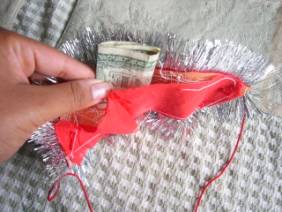
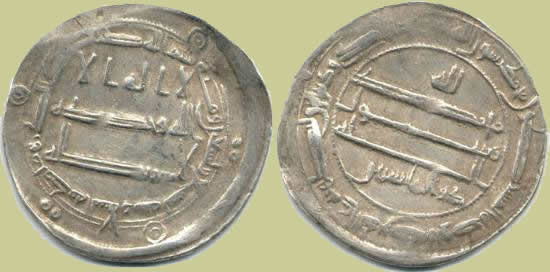
Coins
from the Abbasid caliphate, Ma’moun (AH194-218), Dirham, Madinat-al-Salam,
199AH
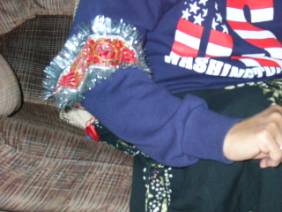
The
Imam Zamin a 53 year old woman received upon coming to America from India.
She is modeling the location of the Imam Zamin (on the right arm).
Photograph by Sarah Aleem.
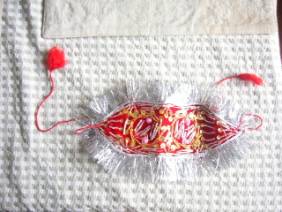
Imam
Zamin from India. A 53 year old was given this ornate Imam Zamin upon
coming to America from India. Photograph by Sarah Aleem.
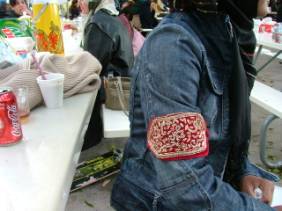
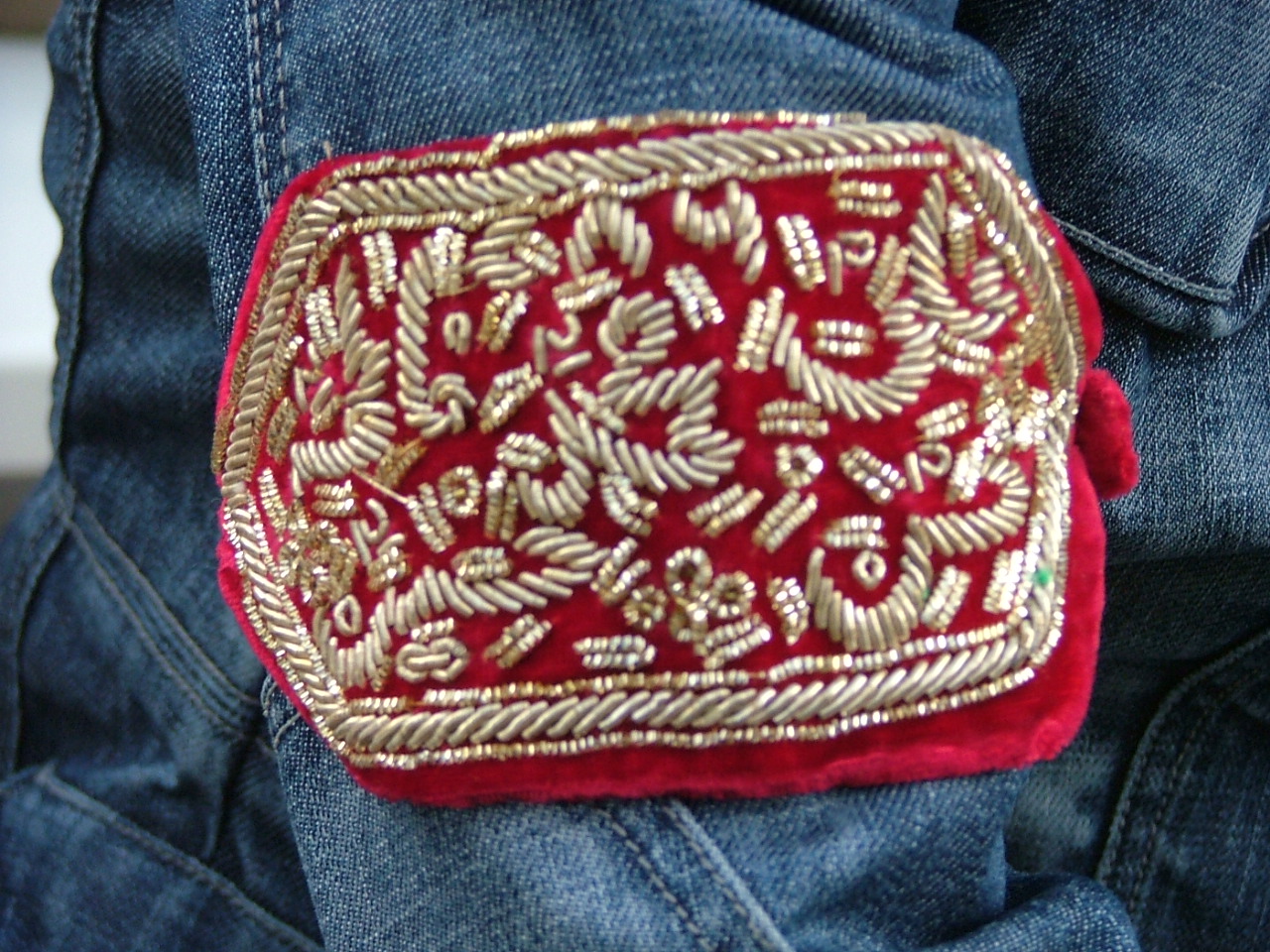
Ornate Imam Zamin. Photographs by Tasneem Sabri.
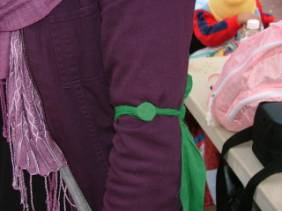
Simple
Imam Zamin. Photograph by Tasneem Siddiqui.

Veer-Zaara,
a Bollywood film featuring a segment that
involves the Imam Zamin.
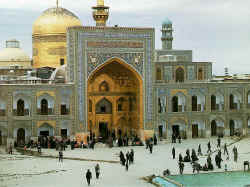
Shrine
of Imam Reza, Mashad, Iran.
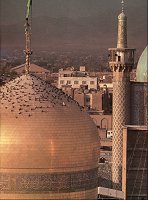
The Dome and Minarets of the Holy Shrine Imam Reza.
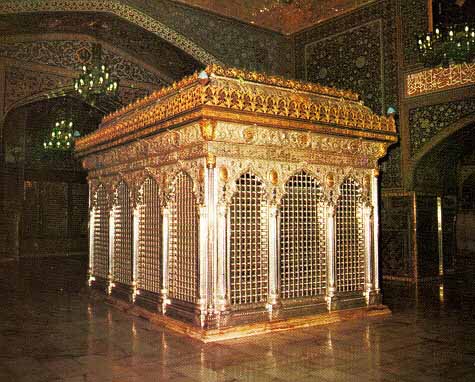
Imam Reza Tomb
Imam Reza was poisoned and died in 817 in Sanabad. The place of his burial
was named Mashhad ( the place of martyrdom) Imam Reza is the only one
of the twelve Imams buried in Iran.
|